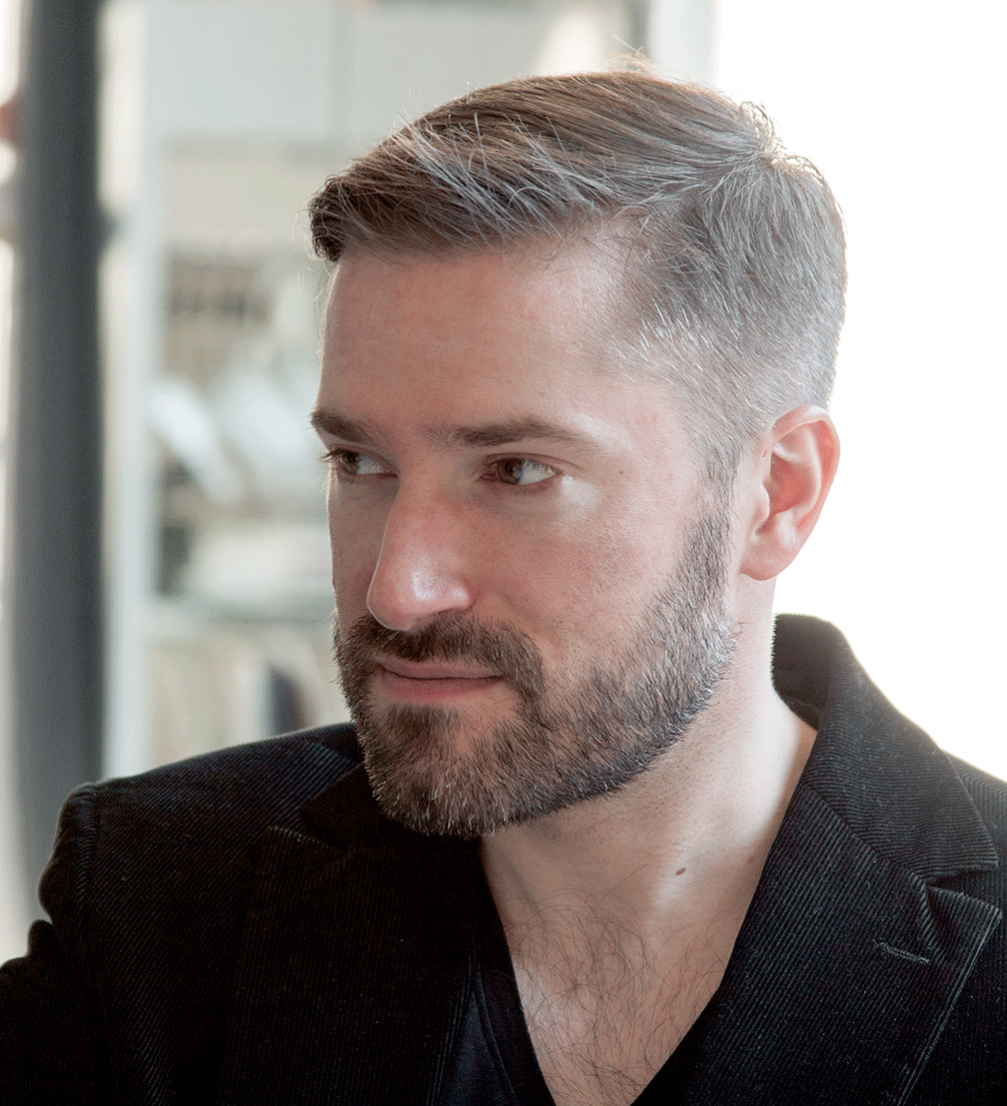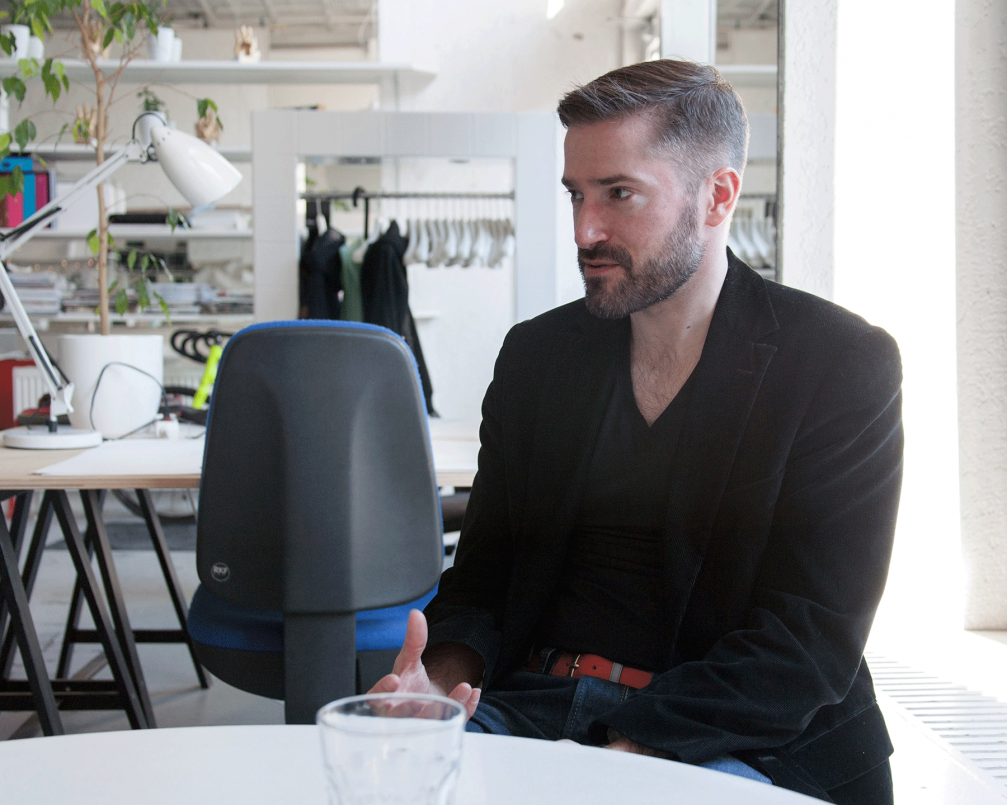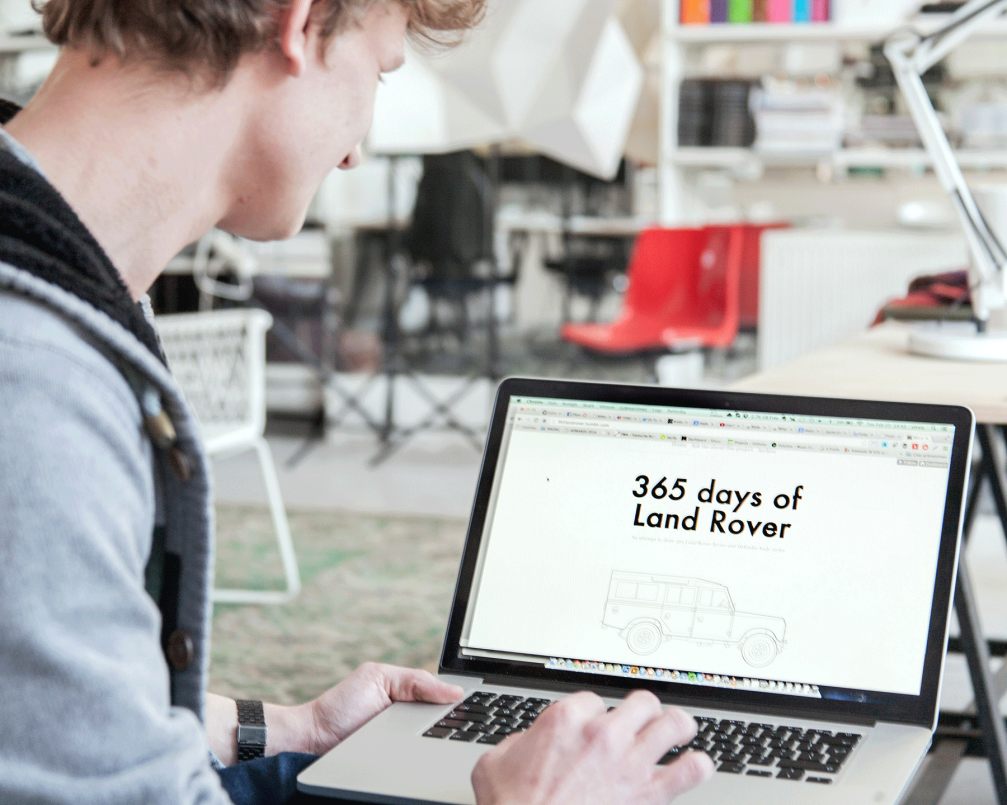
Whenever Latvian Art Directors Club (LADC) brings another great mind to Riga, we have the privilege to interview them. When Isaac Pinnock, design director of London’s innovation agency Made by Many, visited Riga last spring, we sent Edgars Zvirgzdiņš and Oskars Cirsis to meet him.
Made by Many is an international innovation workshop with offices in New York and London. Isaac is a founding partner and leads its design team, where he employs his experience in rapid prototyping and interaction design to transform business requirements into viable and desirable customer experiences.
Edgars:
— How did you come up with the name for the company and what does it mean to you?
Isaac:
— We’ve always believed in the collaborative approach to working, that many people are contributing to one idea. Also, our ideas, the things we build are never really finished until they are out in the real world and being used by many people. So that is the double meaning of «many». It did take us a long time to come up with a good name and lots of bad names got rejected. We actually did an exercise «what we shouldn’t call ourselves» [laughs], and the top rejected name was «fluffy». We wanted to be human.
Oskars:
— Who were the people in the founding team and what were their roles?
Isaac:
— There were four of us, we founded it back in 2007. We started two weeks before the financial crash. Scary timing… We have always been lucky that the four of us have complementary skills that are quite different, so I represent the design side, William represents business strategy, Stuart represents technology and then Tim represented new business and idea generation. Having four different backgrounds means that there has always been a good push–and–pull between the four of us. We never wanted to be an agency that is known only like «the design guys» or «the technology guys».
Edgars:
— What is it exactly that you do?
Isaac:
— We want to make stuff that matters, that actually has some impact, that is useful and that has a quality of making you come back to it. It’s not about campaigns or social media or micro sites or stuff that is just meant to sell stuff. It’s about being able to take a brand and make it more relevant and more useful to people, whether it’s connecting classrooms or a mobile wallet that makes it easier to pay for things. Those are all the things that add some value to somebody’s life.
Skype in the Classroom by Made by Many
Edgars:
— Would you call yourselves digital product designers? Is it a digital product or experience that you design?
Isaac:
— There is another term going on at the moment. It is «venture design» — like venture capital, because you’re kind of combining that element of business change plus coming up with a new service or a product and being actually able to build and design that thing.
Oskars:
— So you don’t go deep into building systems or programs, you are more at the front side? Do you work together with other agencies?
Isaac:
— One of the interesting little things in our history is that we originally started by saying that we won’t have any developers whatsoever, that we’re just going to team with other agencies to be able to build the technological side. That was because we had come from companies and agencies that ended up with big development teams, and the agency’s entire purpose was to sell more work to be able to keep the developers happy. And then half way through our first and second project we realised that it meant that we were entrusting the final product to people that we had no real control over and that didn’t share the passion of our idea and didn’t understand the strategy. That is when we decided to do more in–house, to build it with our own technologists.
Developers need to be involved at the beginning of the process, so that they understand and contribute to the idea as well.
The second part about how we work is that we’ve always been very collaborative, we have never seen projects as a waterfall, where strategists or planners come up with some thinking and then it gets handed on to another person, and another information architect gets involved and hands it on to another designer and another developer. We’ve always believed that working together at the same time is where the more interesting things happen.
Oskars:
— You said that you involve the whole team at the beginning of the process. What is the beginning?
Isaac:
— Nearly all our clients come to us because they don’t know what they want, they kind of only know where they want to end up. Rather than being given a traditional agency brief, often it is a really collaborative process with a client to work out exactly what we’re trying to achieve. Usually we have the vision phase, which is about 4 to 6 weeks long, where we’re doing a lot of interviewing, a lot of research, a lot of testing of small ideas to be able to find out what exactly the scope of the project is going to be. And then at the end of that phase we end up with 4 or 5 propositions that tested well and we recommend them to the client. Usually there is a business modelling as well, because we help move companies into spaces where they haven’t been before.
Oskars:
— Is it easy to convince clients that they need those 4 to 6 weeks of research?
Isaac:
— I’ll give an example — ITV news came to us couple of years ago and they had quite a firm brief. They had looked at other news sites, such as BBC or The Guardian, and said that they should have that too. But all those guys are doing a really good job with the sites they’ve got, and that doesn’t leave much space in the market for another site that is exactly the same. So surely you should be looking at what you could do differently.
It’s impossible to say at the beginning of the project «yes, we know exactly what we want», because you haven’t discovered that yet.
You haven’t tested it with any users, you don’t know if your business is capable to do that. How can we tell what’s the cost of the project if we haven’t discovered what it is yet? That is why we always end up breaking things down into this vision phase, which is an easy chunk of money for the client to be able to say «ok, I know exactly what I’m going to get at the end of that process».
Edgars:
— So from what I gather is that you mostly work with briefs, where people sense that they have to change something but they don’t know what exactly it is.
Isaac:
— Yes, the brief usually comes out at the end of it and as an agency we don’t use the word «brief», it’s more the problems that we have to solve and what is it that the client wants to achieve. I think that’s the re–education of clients and it does obviously depend on the problem you’re solving.

Oskars:
— What is the culture like in your office?
Isaac:
— Because of our collaborative nature, there are no departments, it’s an open space, and we sit by the project teams, the designer and the developer, and others. I sit together with the team that I’m working with. Then every three months we all move around desks to keep everything fresh and alive. That flat structure applies to the entire company. Even though I lead the creative team, I never call myself the creative director, unless I’m at a party and I want to impress someone. But in the office, in front of the client I would never say that. Everyone in the entire company has an equal right and expectation to be creative; everyone is responsible for coming up with an idea.
Edgars:
— You mentioned that you do events. What kind of events are those?
Isaac:
— Front–end London is one of the biggest and most successful events that we have done. It takes place every single month at our office and it’s a gathering of about 60 front–enders, developers, designers. It came about because one of our guys, a regular employee, said that it would be cool to share some of this knowledge and be able to get other people in to talk about the subject, and he asked if they could use the office on the last Thursday of the month, and I just said «yes, go for it». And now it’s a phenomenally successful event, the tickets sell out within about 30 seconds each month, they are just gone.
Oskars:
— What is the thing that you get out of these events?
Isaac:
— It’s definitely not about making money, it’s about making connections, and being able to have a conversation. There was one year when we took the whole company to SXSW in Texas, and the best thing by far at the end of each day was being out together in a pub and having a free ranging conversation about what happened today. That same passion that goes into your work naturally flows over and you end up having interesting conversations, you make new discoveries, and someone else’s viewpoint can change the way you feel about something. And you should hire people that you want to talk to.
Hackaball by Made by Many
Oskars:
— Besides the agency work, do you work on any side projects just for yourself?
Isaac:
— The only side project that I do at the moment is the stupidest thing in the entire world. I’ve always loved Land Rovers, always wanted them when I was a kid and had a couple when I was an adult. About five years ago I started doing line art illustrations of every single body style that Land Rover has ever made. I wanted a gigantic poster and now I’m about 30 body styles away from having finished it.
Edgars:
— How many did they have?
Isaac:
— 365. So if you have a look at 365landrover.tumblr.com, I’ve started putting them up there. That’s a really silly project, but one day I’ll finish it.
We’ve had some side projects at work over the last couple of years. One was called Hologram, the other one — Picle. One of our guys said, «I wonder what Instagram would sound like». So he went on a day trip to a beach, he was taking pictures and at the same time recording the sound, he merged everything together and produced a short video and put it on our blog. The reaction was so good! We managed to give him some time and a developer. I think we went to SXSW with 15 users of Picle and came back with about 35 thousand users.
Unfortunately, the most difficult thing about side projects is that you have to treat them as if they were a client themselves. You have to assign them a budget, even if that is a mythical budget.
Picle could have been as big as Vine or Instagram Video, but it was just ahead of its time and it suffered of not having as much love as it needed.

Edgars:
— Do you think it’s the future for designers and companies that you start becoming the creator yourself for those ideas?
Isaac:
— The best way of having an experience is just to go and do it, not waiting on clients. One of the reasons why we did Hologram was because we wanted to learn more about mobile development. We didn’t have any clients with mobile projects, so we would hire somebody and just do our own thing.
Edgars:
— Can you tell us more about Hologram?
Isaac:
— Hologram was a really fun thing. The iPad had come out and we wanted to make something fun with it, like a free gift from Made by Many. One of our young guys, a really talented designer, came up with an idea of using iPad as a physical messaging platform, so being able to choose from a deck of cards and hold it up in the middle of a talk and just say «It’s fantastic!», «I’ll have a barbecue», or whatever. So a simple idea, but really well executed. The best thing was that people ended up using it in different ways. There was a school for deaf people in Australia and Apple gave 150 free iPads to them and they included Hologram as one of the default apps, because they thought that it was a great way of communicating for deaf children.
Edgars:
— Could you tell us more about your prototyping process for websites and interfaces?
Isaac:
— Prototyping with a piece of a paper is a really valuable thing. We often design the elements of the interface, including content and features and functionality, we cut it into different sections; give them to the users on the table and ask to prioritise them. So we’re able to find out very quickly how they are responding to different things and what they value. The prototyping tool that we use the most often is Keynote. Most of the time it’s just quite simple objects, colour boxes — the features of Keynote make it so easy and quick to make something. We tend to make things with quite a lot of real content inside of them. If you use grey boxes with diagonal lines or too much Latin copy, it starts getting distracting. And then we use Flinto for all the mobile prototyping, it’s a cool web based interface allowing to merge a bunch of images together and create something that you can use very easily and hand over to a real user.
Edgars:
— You talk a lot about user testing. How do you approach it?
Isaac:
— Our entire process is evidence driven. User testing is baked into the project process almost form the day one, because you can only find out what is the best product by testing real people. I think we have never done a user testing session, when we haven’t got something that is useful. We often test two people at a time, like friends, because that kind of a relation keeps both of the people honest. When you’re dealing with an app that is going to cost millions of pounds and will be used by millions of people, you have to put that effort in to know, is this the way the people are going to use this, and does it make sense.
Oskars:
— With websites the end never comes, there are tests, changing goals, and something’s always not working…
Isaac:
— Yes, it’s never that clean. Especially if you’re building something that’s really integral to the success of the business and you’re trying to do something new, then you’re training and teaching that business to take on the project themselves. Like with ITV News, where they have 300 journalists, we had to build a system that would allow any of those journalists to update and add content themselves. You’ve really got to understand how they work and how their business works. That means you can’t just go «here, it’s yours», you have to be able to work side by side with them for a long time.
Even with our London clients, we invite them to work in our office for a bit, there is enough space to sit and be side by side.
Working alongside your client and actually being in the same space, that is the secret source.
I have never really liked when there is the grand reveal at the end of the project. In every our project the client has been walking alongside us.
Viedokļi